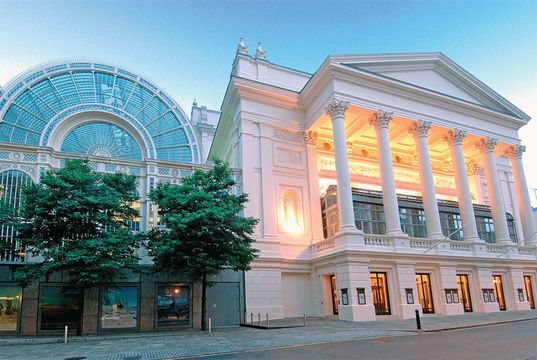
The Royal Opera HouseGetty: Images
It would be a mistake to assume that London’s Royal Opera House is an exclusive enclave only for those with expensive tickets for a performance.
Since major renovations were completed in 1999, the Royal Opera House, home to the Royal Opera and the Royal Ballet and affectionately referred to simply as “Covent Garden” by Londoners, has opened its doors throughout the day to the public. Everyone is welcome to wander in and enjoy the premises, and even those with no interest in opera or ballet might find this iconic building worth a visit.
While a theater has been on this site since the 1700s, it was not until 1858 that it became an opera house. The Royal Opera House, designed by Edward Barry, retains its original white façade that was built in a classical style with its main entrance on Bow Street. An adjacent connecting building, a spectacular glass structure called Floral Hall, that was once part of the historic Covent Garden flower market, now serves as the venue’s atrium and public space. Another entrance can be accessed directly from the Covent Garden piazza.
During the day the Royal Opera House is an oasis from the hustle and bustle of Covent Garden with its interesting building tours, free special exhibitions, a very well-stocked shop and the Amphitheatre Restaurant—an elegant setting in which to enjoy lunch or afternoon tea with views looking out over the neighborhood. In the evening this restaurant along with the exquisite Paul Hamlyn Hall Balconies Restaurant and Champagne Bar is available only to ticket holders.
A ballet icon 🤩
Just one week to go until Carlos at 50!
As we head into final rehearsals for this exciting programme celebrating @CAcostaOfficial's birthday, here's a classic clip of his performance in Cubanía.
🎟 https://t.co/RmdokMfwfI pic.twitter.com/fHujgzD9ww
— Royal Opera House (@RoyalOperaHouse) July 19, 2023
Backstage tours offer insight into what preparations are necessary for a live performance. Depending on the day a tour may stop by a rehearsal room where the Royal Ballet is going through its exercises, while another may enter rooms where props and costumes are being made for an upcoming opera. Some tours focus on the architecture of the Royal Opera House and the luxurious theater itself which has a seating capacity of 2,257 in a horseshoe shape on four levels.
Read more
Enter the Royal Opera House from the Covent Garden piazza and the gift shop is there on the left-hand side with appealing items adorning its windows. Some items in the shop will be of immediate interest to opera lovers, while others like the beautiful damask travel bags and pieces of jewelry will catch everyone’s attention. Just beyond the shop is the Box Office where tickets can be booked for performances as well as for one of the organized tours. Throughout the year free exhibitions celebrating individuals, significant moments, and the history of the Royal Opera House are on display in the costume cases and the Amphitheatre Gallery.
Finally, of course, it is opera and ballet that beckon people night after night to this world famous venue. While opera ticket prices have long been associated with those at the top end of the economic bracket, today’s Royal Opera House is making a strong effort to include a wider population with many seats at each performance priced at £40 and even less. Antonio Pappano, the dynamic conductor and Music Director of the Royal Opera since 2002, offers an inside look at what it is like to work here: “Walking into this building each day knowing that I have a fantastic auditorium, world-class orchestra and chorus and all manner of exciting guest artists, I feel I am the luckiest musician on the planet. We are a family here at the Royal Opera House—we live and breathe opera because we are addicted to its emotional power.”
— Jennifer Dorn
For more information
go to www.roh.org.uk
*Originally published in 2018.





Comments